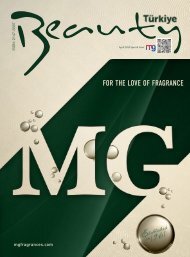SleepTech_January - February 2019
SleepTech_January - February 2019
SleepTech_January - February 2019
You also want an ePaper? Increase the reach of your titles
YUMPU automatically turns print PDFs into web optimized ePapers that Google loves.
54<br />
removed from the market or are<br />
no longer produced. However,<br />
because they do not easily break<br />
down, they can remain persistent<br />
in the environment for years.<br />
Flame-retardant finishes provide<br />
textiles with an important performance<br />
characteristic. Protection<br />
of consumers from unsafe fabric<br />
is only one area where flame<br />
retardancy is needed. Firefighters<br />
and emergency personnel require<br />
protection from flames as they go<br />
about their duties. Floor coverings,<br />
upholstery and drapery also need<br />
protection, especially when used<br />
in public buildings. The military<br />
and the airline industry have<br />
multiple needs for flame-retardant<br />
textiles.<br />
The requirements for a commercially<br />
successful flame-retardant<br />
textile product have been given<br />
as meeting flammability requirements:<br />
having little or no adverse<br />
effect on the textile’s physical<br />
properties; retaining the textile’s<br />
aesthetics and physiological<br />
properties; being produced by a<br />
simple process with conventional<br />
equipment and inexpensive<br />
chemicals; and being durable<br />
to repeated home launderings,<br />
tumble dryings and dry cleaning. It<br />
has been possible to meet these<br />
requirements for many textile<br />
products since before 1983 and<br />
our society enjoys a safer environment<br />
as a result.<br />
Progress is continuing in this<br />
field and recent reviews have<br />
highlighted advances in the<br />
understanding and chemistry of<br />
flame-retardants, but progress<br />
has been relatively slow and the<br />
advances quite minor and specialized.<br />
Two excellent reviews have<br />
appeared and should be required<br />
reading for those wishing to have<br />
a comprehensive understanding<br />
of treatment with flame-retardant<br />
finishes. This chapter will cover<br />
the same ground in a much more<br />
general way.

















